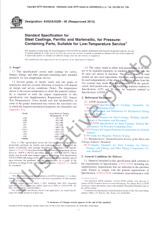We need your consent to use the individual data so that you can see information about your interests, among other things. Click "OK" to give your consent.
ASTM D8414/D8414M-21
Standard Test Method for Measurement of Jet Cup Attrition Index of Catalytic Materials
Translate name
STANDARD published on 1.10.2021
The information about the standard:
Designation standards: ASTM D8414/D8414M-21
Publication date standards: 1.10.2021
SKU: NS-1043823
The number of pages: 9
Approximate weight : 27 g (0.06 lbs)
Country: American technical standard
Category: Technical standards ASTM
Annotation of standard text ASTM D8414/D8414M-21 :
Keywords:
attrition, catalyst additives, catalytic materials, FCC catalyst, fluid catalytic cracking catalyst, JCI, jet cup, jet cup index, powdered catalyst,
Additional information
| Significance and Use |
|
5.1?The jet cup attrition test will provide an estimate of the relative attrition resistance of fluid catalytic cracking (FCC) catalyst, catalyst additives, and catalytic materials. 5.2?The test is designed to simulate the attrition a catalyst or additive undergoes in a fluid catalytic cracking unit but at an accelerated rate. 5.3?The data from this test can be used to rank catalyst according to attrition rate. 5.4?The test requires a relatively small sample size of 5 g [0.175 oz] and a relatively short analysis time of 40 min. This test should be useful to quality control facilities that require fast turnaround time and research and development (R&D) facilities that have limited sample material. |
| 1. Scope |
|
1.1?The jet cup attrition test is applicable to fluid catalytic cracking (FCC) catalysts, catalyst additives, and catalytic materials. 1.2?Applications for other powdered catalysts have been reported in the literature. The round robin test samples included two FCC catalysts and one powdered alumina. 1.3?UnitsThe values stated in either SI units or inch-pound units are to be regarded separately as standard. The values stated in each system are not necessarily exact equivalents; therefore, to ensure conformance with the standard, each system shall be used independently of the other, and values from the two systems shall not be combined. 1.4?This standard does not purport to address all of the safety concerns, if any, associated with its use. It is the responsibility of the user of this standard to establish appropriate safety, health, and environmental practices and determine the applicability of regulatory limitations prior to use. 1.5?This international standard was developed in accordance with internationally recognized principles on standardization established in the Decision on Principles for the Development of International Standards, Guides and Recommendations issued by the World Trade Organization Technical Barriers to Trade (TBT) Committee. |
We recommend:
Technical standards updating
Do you want to make sure you use only the valid technical standards?
We can offer you a solution which will provide you a monthly overview concerning the updating of standards which you use.
Would you like to know more? Look at this page.




 Cookies
Cookies
